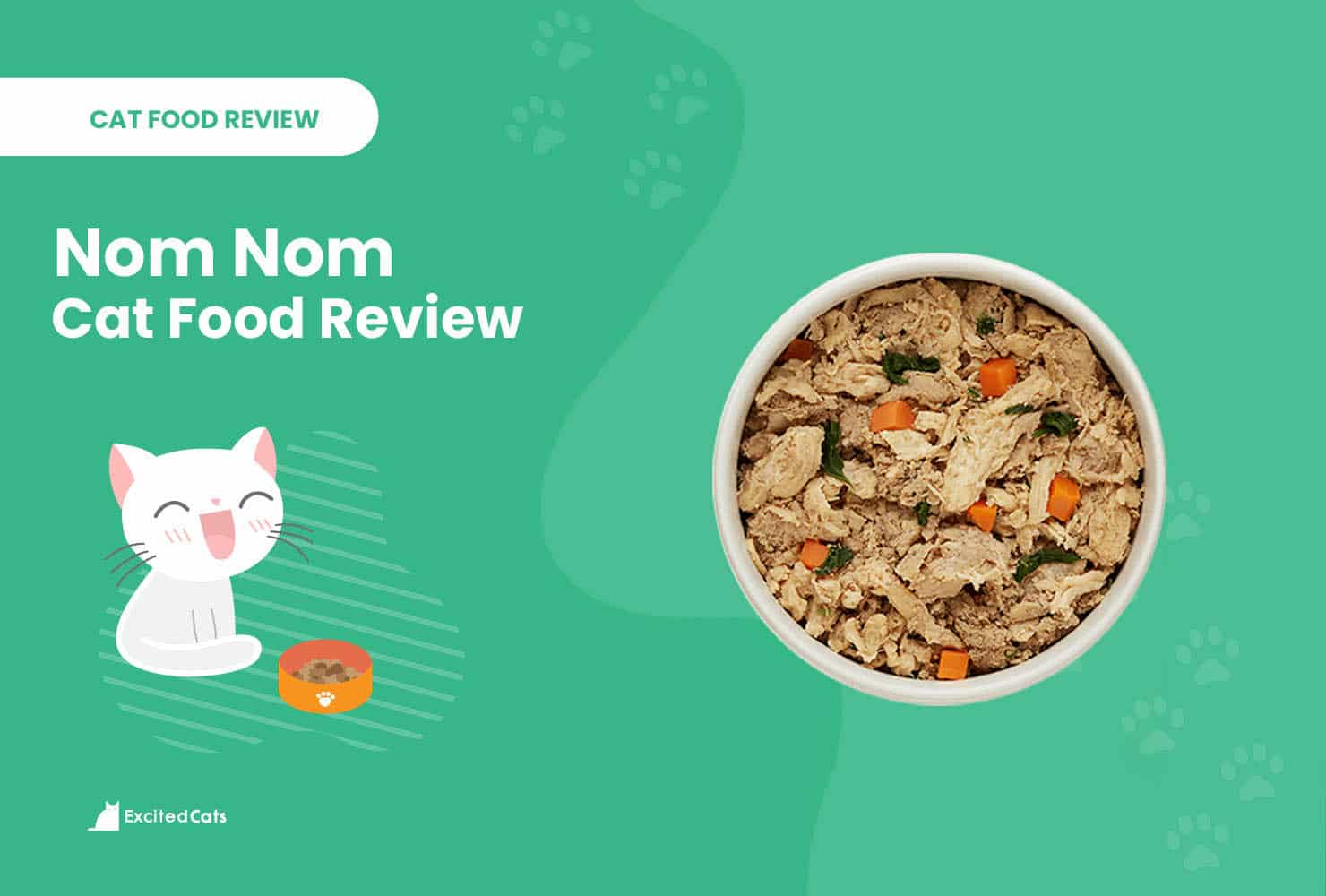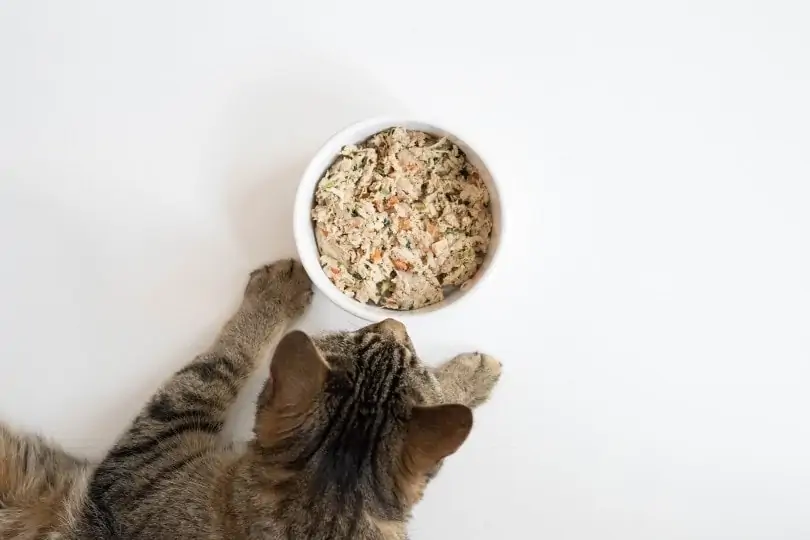Click to Skip Ahead
Disclaimer: Nom Nom has discontinued its fresh cat food recipe and is no longer taking orders. Nom Nom hopes to return to providing fresh food to cats in the future when they have more readily available high-quality ingredients.
We have not changed our review below, though we have removed all links to their website since the cat food is no longer available.
We do, however, highly recommend Smalls Fresh Raw Cat Food Subscription Service in its place.
You can read our extensive review of Smalls here.
Review Summary
We give Nom Nom Cat Food a rating of 4.6 out of 5 stars.
Nom Nom Now, fresh cat food delivery is a relatively new concept for the Nom Nom company, which has delivered fresh dog food to dog owners’ doorsteps since 2015 and has gotten rave reviews.
Now, the company is moving into delivering fresh cat food to cat lovers everywhere. The cat food, as is all fresh food at Nom Nom, is produced by an in-house team of pet experts in their own kitchen in the USA. In this way, they are guaranteed to know what’s in the cat food they send out to their customers.
This cat food is for cat owners who want only the best for their pets and want to feed them food with wholesome ingredients that aren’t full of fillers and unhealthy ingredients.
The meals are proportioned according to the health requirements of your cat, and each portion is prepared with love and care by the in-house team.
Our final verdict of Nom Nom Now’s fresh cat food is 4.6 stars out of 5 stars. So, if you’re looking to make sure your cat is healthy, happy, and loves the food you feed him, then in our opinion, Nom Nom Cat food can deliver just that in spades.
Keep reading below to learn more about Nom Nom cat food and what it can do for your feline friend.
At a Glance: The Best Nom Nom Cat Food Recipes
We could only try out one of the Nom Nom cat food recipes as their Flavorful Fish Feast has been discontinued. However, we will review their Chicken Chow-Meow recipe below.

Nom Nom Cat Food Reviewed
The cat food that Nom Nom prepares is always cooked fresh, and in small batches, so it’s not processed like other cat food brands on the market today. Since it’s not processed, it doesn’t lose the nutrients, vitamins, and minerals your cat needs to be healthy and happy.
We found that this cat food will end up costing you around $2 to $6 a day, according to the size of your cat and how much you feed him daily.
Who Makes Nom Nom, and Where Is It produced?
As previously stated, Nom Nom is made by an in-house team and produced in the company’s locations of San Francisco, CA, and Nashville, TN. Both locations are FDA-approved, and the company only uses USDA-certified ingredients that they source locally. All ingredients are from the United States and are guaranteed to be fresh and healthy for your cat.
Since every meal is cooked to order and portioned according to your cat’s weight goals, actual weight, and age, you can be sure your wishes are being followed. Cooking meals to order also means that the company has zero waste.
Which Types of Cats Is Nom Nom Best Suited For?
Nom Nom cat food is suitable for any cat since the food is fresh and locally sourced. As with any cat food, however, it’s best to talk to your vet before making a final decision.
The Downside of Nom Nom Cat Food
The only downside we could see to Nom Nom cat food is the price. If you have a larger cat, it could cost you quite a bit to feed them every month if you only provided them Nom Nom fresh cat food. However, the peace of mind in knowing that you’re getting only the best for your feline is a good tradeoff, in our opinion.
Best Features of Nom Nom Cat Food
There are quite a few features of Nom Nom cat food that we love.
- The meals are fresh and made of fresh ingredients
- You get pre-portioned meals
- The nutritional content and all ingredients are on the website
- All cat food packaging is recyclable
Recall History
Nom Nom had its first-ever recall in 2021. The voluntary recall was from their supplier, Tyson Foods Inc. Certain chicken products produced by Tyson were potentially contaminated with Listeria monocytogenes, which affects chicken sold for human consumption—the Chicken Cuisine recipe. Only certain bags were being recalled, based on serial numbers of packaging.
Review of the Nom Nom Cat Food Recipe
As stated above, there’s only one cat food recipe to choose from with Nom Nom at the moment, as their fish blend has been discontinued. So, for our purposes, we’re going to be reviewing the Chicken Chow-Meow recipe below.
Chicken Chow-Meow Recipe
Ingredients: Chicken thigh, chicken breast, chicken liver, carrot, asparagus, cantaloupe, spinach, dicalcium phosphate, calcium carbonate, salt, taurine, choline bitartrate, zinc gluconate, ferrous sulfate, vitamin E supplement, copper gluconate, manganese gluconate, thiamine mononitrate (vitamin B1), selenium yeast, riboflavin (vitamin B2), vitamin B12 supplement, cholecalciferol (source of vitamin D3), potassium iodide.
The Chicken Chow-Meow Recipe is made up of high-quality ingredients. It seems that protein in the form of chicken thighs, chicken breasts, and chicken livers are used. All of these are rich in vitamins, minerals, and other nutrients your cat needs to stay healthy. Carrots, spinach, and cantaloupe are also featured ingredients in the food, and Nom Nom Nutrient Mix is a mix made by Nom Nom that is full of nutrients and minerals.
With an overall content of protein at 56.4%, a fat content of 30.44%, and a carb content of 13.6%, we are extremely happy with this cat food’s ingredients and health value.
While we love the health value of cat food, it has quite a few plant ingredients, and it could be a bit pricey for some pet owners’ budgets. It’s also unfortunate that there aren’t more varieties to choose from.
- The food is rich in animal-based proteins
- Contains no artificial colors, flavors, or preservatives
- The food also contains muscle and organ meats
- At the moment, the cat food only comes in one flavor and has only one recipe
- It could be a bit pricey for many cat owner’s budgets
- Contains quite a few plant ingredients
What Other Users Are Saying
Users seem to be quite happy with the Nom Nom cat food they’ve received so far, as evidenced by the quote below.
- Nom Nom website: “I adopted two rescue kittens who had parasites, dull coats, and coarse, nasty stool. Now they gobble their Nom Nom and have beautiful, silky coats, and their litter box is not a toxic hazard.” Read more reviews by clicking here.
Final Thoughts
This concludes our review, pros, cons, recalls, and final verdict of the Nom Nom cat food. The food contains healthy ingredients and great features and is easy to order. Our only concern was that it could be a bit pricey for some pet owners, especially if you have a larger or even multiple cats.
However, the fact that your cat will love the taste, be healthy and happy, and the food gets delivered to your doorstep makes it worth the price you pay to us. As with any pet food, consult your vet before making a final decision on what is best for your feline companion.
- Check out our complete list of cat food reviews here

















